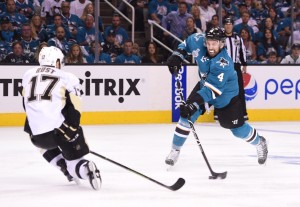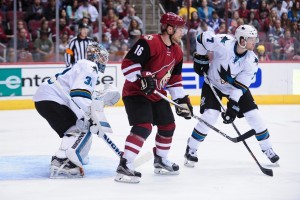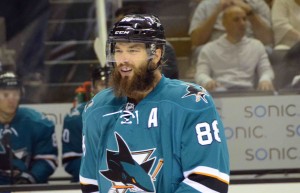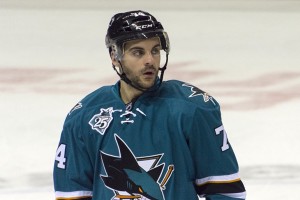We are on to part 3 of our review of the Sharks season. To catch up on the first two parts, you can hit the appropriate links.
- Main Points
- Forwards
- Defense
San Jose played nine defensemen this season. Five formed the core group. The top two pairings featured Marc-Edouard Vlasic with Justin Braun and Brent Burns with Paul Martin. Brenden Dillon was locked in as the third pair defenseman on the left side. Four non-core defenseman played the role of Dillon’s partner, starting with Matt Tennyson, followed by Mirco Mueller and Dylan DeMelo before finishing the season with Roman Polak.
The Core Group

Brenden Dillon had a huge turnaround season and might be most improved player on the team if not for another defenseman’s dramatic turnaround. The big, rugged lefty went through multiple partners and, somewhat ironically, finished with the player he had the least chemistry with. Overall, he finished the season plus-8, after a miserable minus-11 the prior year. His playoffs, however, were less than his regular season.
The pairing with Polak began after Polak was acquired just prior to the trade deadline. Dillon and Polak are similar style players with similar weaknesses. In the regular season, it seemed an awkward fit, but not terrible. In the early playoff rounds, the physicality helped, even if the play was uneven. By the final round, though, the pair was exposed. They committed too many turnovers in their own zone, many of which proved costly. Pittsburgh’s Carl Hagelin alone forced three turnovers turned scores on this pair.
Vlasic was, once again, the Sharks top defenseman in plus-minus in both the regular season and playoffs, finishing plus-15 and plus-14 respectively. DeBoer’s system encouraged the defensive stalwart to be more offensively aggressive and he put up his best point total for his career (39), even though he missed 15 games. Vlasic also had more responsibility on the power play, seeing time with the top unit when Logan Couture was out. Vlasic was paired mostly with Justin Braun. Braun was more hit and miss this season, often finding himself looking the wrong way on scoring plays. Still, he played hard and was a solid contributor, finishing at plus-11 and tying a career high with 23 points. The Braun-Vlasic pairing was a ‘tilt the ice’ combination, assigned to play the tougher defensive starts against the better players, and still coming out ahead. Vlasic did not seem to register as a Norris contender, though he was probably the team’s best defenseman over the entire season.

Paul Martin was a smart signing in the offseason by general manager Doug Wilson. Martin proved his worth. He was an effective player in his own right, though overshadowed by his partner. Despite turning 35 during the season, Martin played 78 games, the most he played in a decade. His stay at home style and ability to read plays quickly meant he fit the Sharks scheme perfectly. A sign of Martin’s value came early in the season, when Martin missed three games and San Jose lost all three. Martin finished the regular season with 20 points and was plus-13. In the playoffs, he was plus-5 with five assists.

Brent Burns, the most interesting player in hockey is an uber-talent. There is simply no one else like him in the league. The Sharks defenseman made the biggest turnaround of any player on the team, perhaps the biggest of any player in hockey. Burns has always been an offensive force; he was pouring in points all season long. But at about the midpoint of the season, there were two things missing. He scored points when he was on the ice, but the rest of his team did not. Midway through the season, Brenden Dillon (not an offensive player and commanding far less ice time) had been on the ice for more even strength Sharks goals than Burns.
The second issue was Burns long-standing liability, the defensive side of his game. He bottomed out at minus-15 in early January. And then things turned. On a dime. In a huge way. The seeds of the turnaround probably lie in the changes Peter DeBoer made, but hadn’t really taken root until then. Burns himself seemed to recognize certain things were hurting his game, including getting back too slowly in transition defense and frequent stretch passes turned icings.
By ridding his game of lower percentage plays, Burns was dramatically more effective, a turnaround that earned him a spot as a Norris Trophy finalist. Burns 75 points were second among NHL defensemen, his 27 goals were first. He was also second in the league in shots on goal. Though he still finished minus-5, it was a huge improvement from early January. He added 24 points in 24 playoff games and was plus-11. Burns was often the dominant player on the ice. There were numerous debates over his role, since he was an elite forward just two seasons ago. With his turnaround he is now, at age 31, an elite defenseman.
The Not Core Group

Three of four ‘non-core’ defensemen are not certain for the Sharks roster next season. Matt Tennyson found the doghouse of Peter DeBoer (a horrific game against Chicago probably lingers in the coaches’ memories). Overall, I thought Tennyson played reasonably well. When I wrote about Tennyson early in the season, he had been pulled from the lineup after playing the first 16 games. He was a plus-5 when paired with Brenden Dillon (and Dillon a plus-5 with Tennyson). However, in games with Mirco Mueller, Tennyson was minus-4. Mueller, who also played a few games with Tennyson benched, was minus-4 in his 11 games. The 21 year-old did get his first NHL fight, an important milestone for a player who’ll need to be more physical to hold down an NHL spot. Tennyson is likely elsewhere next season. Mueller was not ready to make the jump to the NHL this year and might be in the AHL again next season.
Roman Polak came to San Jose in a trade deadline move to partner with Brenden Dillon. The Sharks figured rookie Dylan DeMelo, who partnered with Brenden Dillon for about half the season, would be a risk during the playoffs. Polak, a bruising defenseman, had minimal chemistry with Dillon. Though his physical presence was an asset in the early rounds of the playoffs, he was, predictably, badly exposed by the Penguins. One senses Polak was a rental and DeMelo, a more natural fit with Brenden Dillon, will take over the role as the team’s sixth defenseman. The smaller and more mobile DeMelo managed four points on the season, all on the power play. He finished the season even. It was a good rookie season. One thing was clear, DeBoer preferred DeMelo’s game over Mueller and Tennyson.
Additional Notes
DeBoer would usually sit his sixth defenseman for much of the third period, whether it was Tennyson, Mueller or DeMelo. He did not trust any of them in the latter parts of close games. The Sharks used a five defenseman approach. The results were mixed. This scheme ended with the arrival of Roman Polak in late February.
Polak played 48 games for San Jose, 24 in the regular season and 24 in the playoffs. His 48 games were more than Tennyson (29) or DeMelo (45).
Brent Burns got the Norris nod, though he was the worst Sharks defenseman in plus-minus by a lot. If the voters look at the whole season, there is no way he should win. If they only look at his play since early January, there is no way he should lose. Burns did tie for the league lead in a surprising category, face-off win percentage. Twenty-three players went undefeated in circle. All 23 took either one or two face-offs for the season. Burns was the Sharks only defenseman to take a face-off.
http://gty.im/539753340
Vlasic missed 15 games, the other four core starters combined missed only 12. Burns did not miss a game. It was a healthy group. In the playoffs, the Sharks used the same six defensemen in all 24 games, the five core plus Polak.
When Vlasic missed time within games, the Sharks paid a price. In the third period of a regular season game against Anaheim, Vlasic missed the period and Anaheim scored the lone goal of the game. Absent Vlasic, San Jose spent the entire period stuck in their own end. Against Pittsburgh in the Stanley Cup Final, he was out for a major chunk of the second period of Game 6. He was matched up against Sidney Crosby for much of the series and it was a great battle. The series winner came during Vlasic’s absence with the Crosby line on the ice. Crosby had the primary assist.
With an NHL expansion draft expected in 2017, San Jose can protect three defensemen, probably Vlasic, Burns and Dillon.